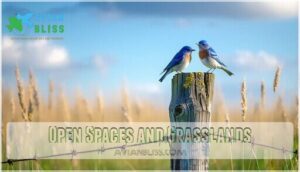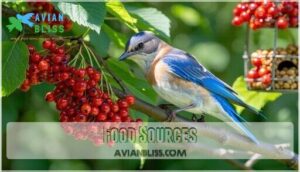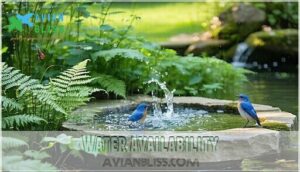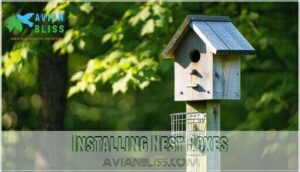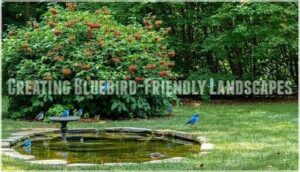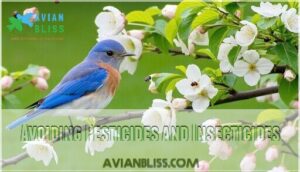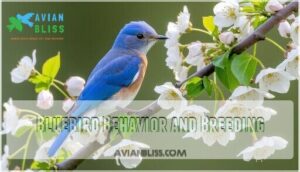This site is supported by our readers. We may earn a commission, at no cost to you, if you purchase through links.
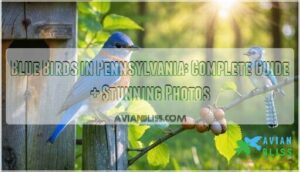
These feathered gems prefer open grasslands, farmland edges, and suburban areas where they can spot insects from fence posts.
Blue jays, with their striking crests and bold personalities, also call Pennsylvania home year-round.
Indigo buntings, though they appear black in poor light, flash deep blue when sunlight hits their feathers just right.
They’re summer visitors who love woodland edges and brushy areas.
Each species has unique habits, from bluebirds’ cavity-nesting preferences to jays’ acorn-hoarding behavior, making identification easier once you know their secrets.
Table Of Contents
- Key Takeaways
- Bluebird History in PA
- Bluebird Habitat Requirements
- Attracting Bluebirds to Your Yard
- Bluebird Behavior and Breeding
- Bluebird Nesting and Breeding in PA
- Bluebird Conservation in Pennsylvania
- Bluebird Facts and Interesting Information
- Frequently Asked Questions (FAQs)
- Are there Blue Birds in Pennsylvania?
- What does a blue bird look like in Pennsylvania?
- Where do Bluebirds nest in Pennsylvania?
- How do you attract bluebirds in Pennsylvania?
- Are bluebirds beautiful?
- What is the best Bluebird conservation organization in Pennsylvania?
- What birds are blue in PA?
- Do bluebirds stay in PA in winter?
- How rare are Eastern Bluebirds?
- What’s the difference between bluebirds and blue jays?
- Conclusion
Key Takeaways
- You’ll find three main blue bird species in Pennsylvania: Eastern Bluebirds, with their brilliant azure wings and rusty-orange breasts, are the most common; Blue Jays, with striking crests, stay year-round; and Indigo Buntings flash deep blue in sunlight during summer visits.
- You can transform your yard into a bluebird haven by installing nest boxes 4-6 feet high, facing away from prevailing winds, providing protein-rich mealworms and suet, maintaining open grassy areas for insect hunting, and avoiding pesticides that eliminate their food sources.
- Pennsylvania’s bluebird population made an incredible comeback from near-extinction in the 1960s, due to DDT and habitat loss, to thriving communities across all 67 counties today, thanks to dedicated conservation efforts, including nest box programs and habitat restoration.
- You can actively support bluebird conservation by joining volunteer monitoring programs, participating in citizen science projects, creating chemical-free environments, and connecting with organizations, like the Pennsylvania Bluebird Society, to help maintain their population success.
Bluebird History in PA
You’ll discover that Pennsylvania’s bluebird population reached its peak around 1900, when extensive farmland created perfect habitats for these beautiful birds.
However, you’ll learn how introduced species, pesticide use, and habitat changes caused dramatic population declines.
Followed by remarkable recovery efforts that brought bluebirds back to every county in the state, which is a testament to conservation success.
Decline of Bluebird Population
Eastern Bluebird populations crashed during the mid-1900s, hitting rock bottom before environmental awareness kicked in.
Pennsylvania’s beloved bluebirds nearly vanished forever, until passionate conservationists stepped up to save them.
Pesticide Impact from DDT devastated reproduction, while Habitat Fragmentation eliminated open spaces they needed. Food Scarcity followed as insects disappeared from chemical use.
Climate Change and development pressure made things worse. Bluebird conservation efforts became critical as bird populations faced this perfect storm of threats across Pennsylvania’s landscapes.
They thrive in semi-open habitats like orchards and suburban gardens.
Impact of Introduced Species
While bluebird populations were already struggling, introduced species like house sparrows and European starlings delivered the knockout punch.
These aggressive invaders didn’t just compete—they dominated, turning peaceful meadows into battlegrounds where native blue birds in Pennsylvania faced an uphill fight for survival.
Notably, invasive bird populations pose a significant threat to native species.
- Competition for resources intensified as invasive species consumed the same insects and berries that bluebirds needed
- Nest site takeover became common, with house sparrows aggressively claiming bluebird boxes and natural cavities
- Disease transmission spread rapidly when non-native birds introduced parasites and pathogens to local ecosystems
- Predation effects increased as some introduced species directly attacked bluebird eggs and nestlings
- Habitat alteration occurred when invasive birds modified nesting areas, making them unsuitable for native PA wildlife
Effects of DDT and Habitat Loss
By the 1960s, DDT Impact and Habitat Fragmentation knocked Pennsylvania’s bluebirds for a loop.
This deadly insecticide weakened eggshells while Insecticide Effects poisoned their invertebrate food sources.
Meanwhile, farmland gave way to suburbs, eliminating the open spaces these blue birds in pennsylvania desperately needed.
The result? A heartbreaking Nesting Decline that nearly silenced their cheerful songs across PA wildlife habitats forever.
Ideal habitats include open woodland preferences with minimal understory.
Recovery of Bluebird Population
You’ve witnessed something remarkable—eastern bluebird populations soaring from near-extinction to thriving communities across Pennsylvania.
This incredible comeback story shows how nest box success and competition reduction transformed bluebird conservation efforts.
Here’s what fueled their amazing recovery:
- Citizen-led nest box programs creating safe nesting sites
- Habitat restoration providing essential open grasslands
- Winter survival improvements through better food sources
- Genetic diversity strengthening through population connections
Conservation Efforts
Anyone can join Pennsylvania’s bluebird conservation efforts through nest box programs and habitat preservation.
You’ll contribute to citizen science by monitoring populations and reducing pesticides in your yard.
Winter feeding supports year-round residents, while community education spreads awareness about bird habitat conservation needs.
| Conservation Method | Your Role |
|---|---|
| Nest Box Programs | Install and monitor boxes |
| Habitat Preservation | Maintain native plants |
| Citizen Science | Record breeding data |
| Pesticide Reduction | Use organic alternatives |
| Winter Feeding | Provide suet and mealworms |
Bluebird Habitat Requirements
You’ll find that Eastern Bluebirds need specific combinations of open grasslands, scattered perches, and nearby trees to thrive in Pennsylvania’s diverse landscape.
Understanding these habitat requirements, which include access to insects, berries, and clean water sources, helps you create the perfect conditions to attract these beautiful birds to your property, leveraging their need for diverse landscape.
Open Spaces and Grasslands
When open habitat management creates the perfect stage, eastern bluebirds become the star performers.
These grassland bird species need clear sight lines to hunt insects, making Pennsylvania’s meadows and farmlands ideal homes.
Bluebird habitat thrives where short grass meets scattered perches—think fence posts and utility lines.
Unfortunately, farmland bird decline threatens these spaces.
PA grassland ecology faces conservation challenges, but restoring native grasses in your yard helps blue birds in Pennsylvania flourish while supporting essential bird conservation efforts.
Food Sources
Bluebirds zero in on diverse food sources throughout Pennsylvania’s seasons, making their diet fascinating to observe.
These insectivores and frugivorous birds adapt their foraging techniques based on availability, creating opportunities for backyard enthusiasts with bird feeders.
Essential bluebird diet components include:
- Insect consumption – beetles, caterpillars, and grasshoppers during breeding season
- Berry diets – elderberries, sumac, and dogwood fruits in fall
- Seed preferences – sunflower seeds and suet for winter feeding
- Seasonal variety – adjusting between protein-rich insects and carbohydrate-heavy fruits
Water Availability
After setting up food sources, water sources become equally important for blue birds in Pennsylvania.
Eastern Bluebirds need clean water for drinking and bathing behavior. Drought impact can force birds to abandon territories, while nesting water supports chick hydration.
Pennsylvania birds thrive with accessible water features nearby.
| Water Feature | Benefits |
|---|---|
| Shallow bird baths | Safe drinking, easy bathing access |
| Small garden ponds | Natural habitat simulation |
| Dripping fountains | Attracts birds through sound |
Attracting Bluebirds to Your Yard
You can transform your yard into a bluebird haven by installing proper nest boxes, providing protein-rich mealworms, and maintaining open grassy areas where these beautiful birds hunt for insects.
Success requires patience and the right setup, but once bluebirds discover your yard meets their needs, they’ll likely return each breeding season to raise their families.
Installing Nest Boxes
Your bluebird houses need smart Box Placement to succeed—mount them 4-6 feet high on poles, facing away from prevailing winds.
Use galvanized Box Materials like metal conduit with proper ventilation and drainage. Install Predator Guards beneath each box to keep snakes and raccoons away. Many options exist for effective bluebird protection.
Space boxes 100 feet from treelines to reduce competition. Regular Box Maintenance and Monitoring Nests weekly guarantees your eastern bluebird families thrive, supporting key bluebird conservation efforts while attracting bluebirds for successful bluebird nesting.
Providing Mealworms and Suet
Several eastern bluebird enthusiasts discover that mealworms and suet create irresistible dining experiences. These protein-packed treats support healthy reproduction and winter survival.
Mealworms
Suet
Essential feeding strategies for attracting bluebirds:
- Mealworm Nutrition provides essential protein during breeding season
- Winter Feeding with suet recipes helps birds survive harsh Pennsylvania winters
- Feeding Schedules work best during early morning hours
- Predator Protection requires elevated bluebird feeders and bird feeders
- Consistent offerings near nest boxes maximize success rates
Many birders find it convenient to buy these treats online.
Creating Bluebird-Friendly Landscapes
Your yard can become an eastern bluebird haven with thoughtful planning.
Plant native plants like elderberry and sumac that produce insects and berries. Add water features like shallow birdbaths for drinking and bathing.
Create shelter creation areas with scattered trees for perching, plus dense shrubs for roosting spots.
Consider sourcing local species to best support the bluebirds’ natural habitat.
This landscape design supports bird conservation while enhancing your bird watching experience in Pennsylvania.
Avoiding Pesticides and Insecticides
Chemical sprays create toxic wastelands where eastern bluebirds can’t find insects to feed their young.
Choose organic gardening methods and pesticide alternatives like beneficial insects, companion planting, and hand-picking pests.
These natural pest control strategies protect safe habitats while supporting bird conservation in Pennsylvania.
Your chemical-free yard becomes a thriving ecosystem where bluebirds flourish naturally.
Bluebird Behavior and Breeding
You’ll discover that Pennsylvania’s bluebirds follow fascinating patterns during their breeding season, from their late February return to their careful selection of nesting sites in open areas with scattered trees.
Understanding these behaviors, including their territorial habits and multi-brood raising techniques, will help you better appreciate and support these beautiful birds in your own backyard.
Mating and Nesting Habits
Your installed birdhouses become stages for fascinating courtship rituals when eastern bluebird males arrive in March. Males flutter wings and sing sweetly, showcasing potential nesting sites to attract mates.
Once paired, females handle nest building, weaving grasses into cozy cups.
Understanding their nesting habits helps you support these beautiful birds:
- Egg laying occurs 4-7 days after nest completion
- Incubation period lasts 11-14 days with female sitting constantly
- Fledgling care involves both parents feeding insects for 18-21 days
- Bluebird trails benefit from clean, well-maintained boxes
Territorial Defense
Once eastern bluebird pairs establish their nesting site, they become fierce guardians of their territory.
Males patrol boundaries using aggressive displays like wing-flapping and loud calls to ward off intruders.
These defense strategies protect their resources from both bluebird competitors and other species:
- Territory size typically spans 2-5 acres around the nest box
- Interspecies competition with house sparrows requires constant vigilance
- Resource guarding guarantees adequate food supplies for their growing family
Bluebirds exhibit aggressive behavior to protect their territory and ensure the survival of their growing family.
Brood Rearing and Fledging
Bluebird parents work around the clock, making up to 350 feeding trips daily to satisfy their nestlings’ enormous appetites.
Parental care intensifies as brood size determines workload—typically 3-5 bluebird eggs hatch into demanding chicks.
Nestling diet consists of protein-rich insects, caterpillars, and spiders.
After 16-21 days of intensive fledgling development, young birds achieve fledging success and courageously leave their birdhouses.
Migration Patterns
During fall and winter months, Pennsylvania’s bluebirds follow ancient migratory patterns shaped by survival instincts.
Some stay year-round, but most head south when temperatures drop and insects become scarce.
- Migration triggers include shorter daylight hours, declining temperatures, and reduced food availability
- Wintering grounds stretch from southern U.S. states to central Mexico, covering up to 2,000 miles
- Stopover locations provide essential rest areas where birds refuel during long journeys
- Migratory routes follow traditional flyways, with birds returning to familiar breeding territories each spring
- Climate change is shifting traditional bird migration patterns, affecting timing and destinations
Bluebird Nesting and Breeding in PA
Pennsylvania’s eastern bluebird breeding season kicks off in March, with proper nest box placement essential for success.
These dedicated parents lay 3-5 pale blue eggs, maintaining precise incubation temperature for 12-14 days.
Fledgling survival rates improve dramatically with well-positioned birdhouses.
Their nesting habits include raising multiple broods through August, though bluebird predators and second brood success depend heavily on habitat quality and your thoughtful breeding support.
Female bluebirds are the primary nest builders, constructing cup-shaped nests.
Bluebird Conservation in Pennsylvania
You can make a real difference in Pennsylvania’s bluebird population by supporting local conservation efforts that have already helped thousands of these beautiful birds thrive.
Between 1981 and 1988, dedicated volunteers working with the Bureau of State Parks successfully helped nearly 10,000 bluebirds fledge from specially designed nest boxes across the state.
Role of The Pennsylvania Game Commission
Since 1895, the Pennsylvania Game Commission has championed eastern bluebird recovery through thorough PGC Bluebird Programs.
They manufacture 9,000 nest boxes annually, conduct species monitoring across all counties, and manage habitat restoration projects.
Their law enforcement protects avian species, while public education initiatives teach Pennsylvania bird conservation.
You’ll find their dedicated efforts have transformed bluebird populations statewide through science-based habitat management.
The Pennsylvania Game Commission’s efforts have been instrumental in the recovery of the eastern bluebird, with a focus on species monitoring and habitat restoration.
Bluebird Society of Pennsylvania
Founded in 1998, the Pennsylvania Bluebird Society champions eastern bluebird conservation through dedicated volunteer opportunities and membership benefits.
Their society’s mission encompasses educational programs and conservation projects across 30+ counties.
You’ll join fellow bird watching PA enthusiasts while supporting common birds PA through nest box monitoring.
With memberships starting at $15, you’re investing in Pennsylvania’s feathered future while connecting with passionate conservationists statewide.
Community Involvement and Education
When communities unite for Eastern Bluebird conservation, magic happens across Pennsylvania.
You can join Educational Programs that teach families about bird watching PA through hands-on experiences.
Volunteer Opportunities with Local Partnerships connect bird enthusiasts community members who share your passion.
Citizen Science projects let you contribute real data while Public Awareness campaigns spread the conservation message.
Together, we’re building Pennsylvania’s bird conservation programs network.
Research and Monitoring Efforts
Scientists track Pennsylvania’s bluebird populations through sophisticated Monitoring Techniques and Data Analysis. Researchers conduct Population Studies while volunteers perform Habitat Assessment across the state, measuring Conservation Impact through detailed records.
Bird conservation research relies on three key approaches:
- Bird population monitoring through nest box surveys and breeding success rates
- Bird behavior studies examining feeding patterns and territorial habits
- Bird ecology research analyzing habitat preferences and migration timing
The Pennsylvania Bluebird Society coordinates these efforts statewide.
Bluebird Facts and Interesting Information
You’ll discover fascinating details about Pennsylvania’s Eastern Bluebirds, from their remarkable ability to see ultraviolet light to their role as symbols of happiness in many cultures.
These surprising facts reveal how bluebirds have adapted to survive harsh winters, maintain complex social structures, and continue to face modern challenges that affect their populations across the state, making them a subject of interest due to their ability to symbolize happiness.
Bluebird Biology and Physiology
Looking beyond conservation efforts, Eastern Bluebird biology reveals fascinating secrets.
Their stunning plumage coloration comes from light scattering, not pigments—basic physics creating nature’s magic.
Avian physiology includes keen sensory abilities for spotting insects from perches.
Bird anatomy features lightweight skeletal structure perfect for quick flights.
Bluebird genetics determine bird size variations, while males sport brighter bird coloration than females during breeding season.
Bluebird Symbolism and Cultural Significance
Beyond their biological traits, Eastern Bluebirds carry deep cultural meaning across Pennsylvania and beyond.
These beloved songbirds represent hope and renewal in countless stories passed down through generations.
Bluebird mythology and folklore connections span cultures worldwide:
- Native American traditions view blue birds as messengers between earthly and spiritual domains
- Literary references from Thoreau to modern poets celebrate bluebirds as symbols of happiness and peace
- Artistic depictions feature Pennsylvania birds prominently in folk art and contemporary wildlife paintings
Bluebird Population Trends and Statistics
Eastern Bluebird populations in Pennsylvania show encouraging regional variations since hitting rock bottom decades ago.
Current distribution covers all 67 counties, with breeding success rates climbing steadily. The state’s bird population monitoring reveals 7,848 young fledged in 2024 alone.
Historical abundance peaked around 1900, declined drastically, but Pennsylvania birds are bouncing back through dedicated bird conservation efforts.
Birders can find detailed species profiles on various websites.
Threats to Bluebird Populations
Bluebirds in Pennsylvania face mounting pressures that threaten their survival.
Habitat fragmentation from development shrinks their territory, while pesticide exposure eliminates vital insects they need.
Invasive species like House Sparrows compete for nest sites, and climate change disrupts migration timing.
Predation pressure from cats and snakes increases near suburban areas.
Understanding these challenges helps you create safer bird habitats through thoughtful bird conservation efforts.
Frequently Asked Questions (FAQs)
Are there Blue Birds in Pennsylvania?
You’ll find Pennsylvania’s home to fifteen blue bird species.
The Eastern Bluebird claims every county, while Indigo Buntings, Blue Jays, and Purple Martins also call this state home year-round or seasonally.
What does a blue bird look like in Pennsylvania?
You’ll spot several blue bird species across Pennsylvania, each with distinct features.
Male Eastern Bluebirds display bright blue backs with rusty-orange chests, while Blue Jays show vibrant blue plumage with black-striped tails and prominent crests.
Where do Bluebirds nest in Pennsylvania?
Ironically, while you’d expect them to build elaborate homes, bluebirds prefer simple spots.
You’ll find their nests in old woodpecker holes, natural tree cavities, or specially-designed nest boxes throughout Pennsylvania’s open woodlands.
How do you attract bluebirds in Pennsylvania?
You’ll want to set up nest boxes in open areas with scattered trees.
Face boxes east, mount them five feet high, and space multiple boxes apart.
Maintain short grass for insect hunting, and plant native berry bushes.
Are bluebirds beautiful?
Absolutely, you’ll find bluebirds stunning with their vibrant azure wings and rusty-orange chest.
Males display brilliant cobalt blue plumage that catches sunlight beautifully, while females show softer, elegant blue-gray tones that create their own quiet charm.
What is the best Bluebird conservation organization in Pennsylvania?
While massive corporations focus on profits, you’ll find Pennsylvania’s Bureau of State Parks leads grassroots bluebird conservation efforts. They’ve helped nearly 10,000 bluebirds fledge through volunteer-monitored nest boxes since the 1980s.
What birds are blue in PA?
You’ll spot fifteen blue bird species across Pennsylvania, including Eastern Bluebirds, Blue Jays, and Indigo Buntings.
Some stay year-round while others migrate through.
Each species shows unique blue patterns and behaviors, including distinct characteristics of Eastern Bluebirds.
Do bluebirds stay in PA in winter?
Most bluebirds don’t stick around Pennsylvania during winter’s harsh months.
They’ll migrate south to warmer states like Georgia or Florida, though some hardy individuals might remain if you’ve got reliable food sources nearby, especially during times when reliable food is crucial.
How rare are Eastern Bluebirds?
You’ll find Eastern Bluebirds aren’t particularly rare anymore.
Their populations recovered substantially since the 1970s thanks to nest box programs.
They’re common throughout Pennsylvania, with every county hosting breeding pairs during spring and summer months, which is a notable result of the recovery, making Eastern Bluebirds a common sight.
What’s the difference between bluebirds and blue jays?
You’ll notice bluebirds are smaller songbirds with rust-colored chests and gentle dispositions.
While blue jays are larger, louder corvids with crested heads, bold black markings, and more aggressive personalities around feeders, particularly noticeable in their behavior.
Conclusion
While many bird species struggle in today’s changing landscape, blue birds in Pennsylvania tell a remarkable success story.
You’ve learned how these vibrant creatures bounced back from near extinction through dedicated conservation efforts. Now you’re equipped with the knowledge to identify Eastern Bluebirds, Blue Jays, and Indigo Buntings in your own backyard.
By installing nest boxes, providing mealworms, and creating pesticide-free environments, you’ll become part of Pennsylvania’s ongoing bluebird conservation legacy while enjoying these stunning azure visitors year-round.
- https://www.pgc.pa.gov/Education/WildlifeNotesIndex/Pages/Wood-Warblers.aspx
- https://www.thebsp.org/
- https://www.allaboutbirds.org/guide/Blue-gray_Gnatcatcher/overview
- https://www.pa.gov/content/dam/copapwp-pagov/en/pda/documents/plants_land_water/plantindustry/gisc/documents/Survey%20responses%20.pdf
- https://abcbirds.org/blog20/invasive-birds/

